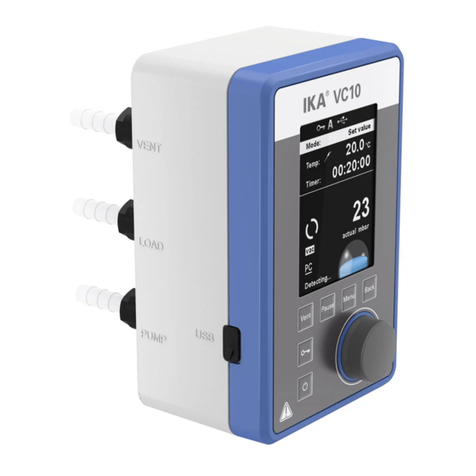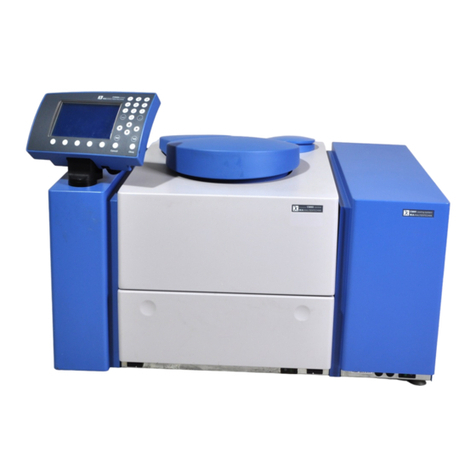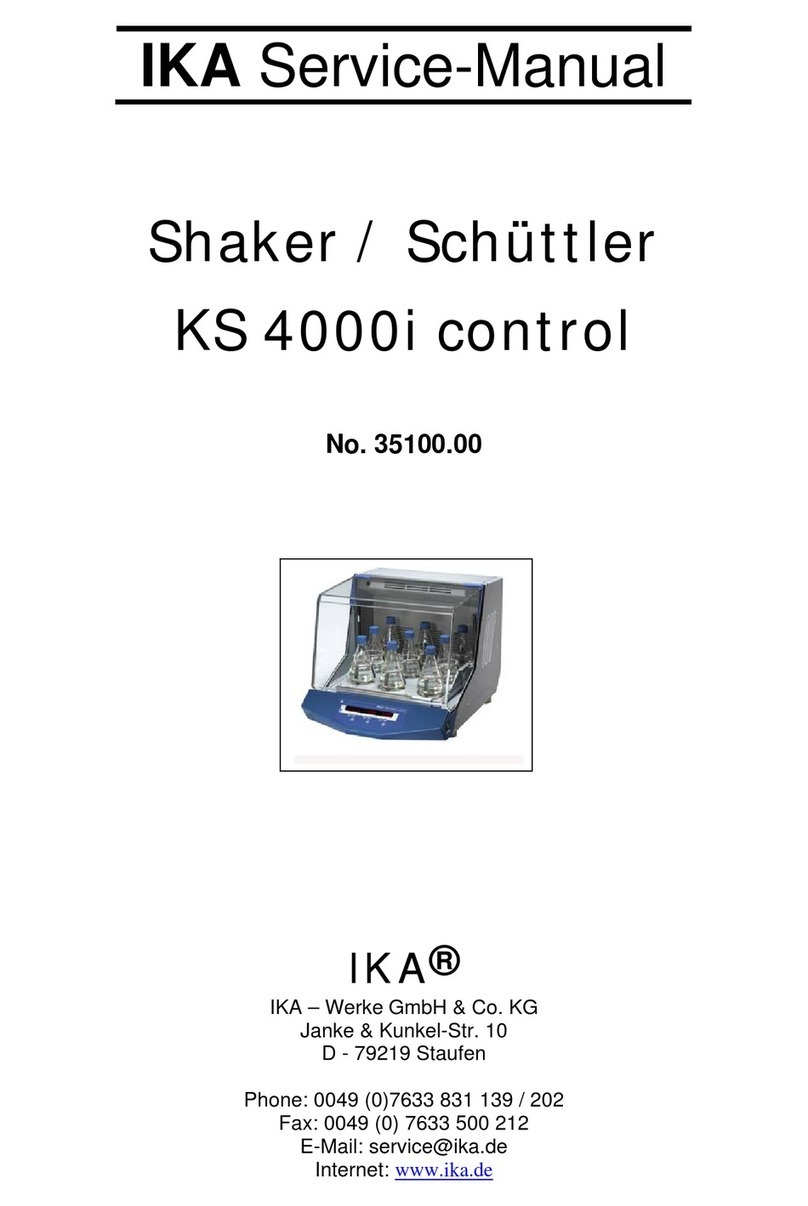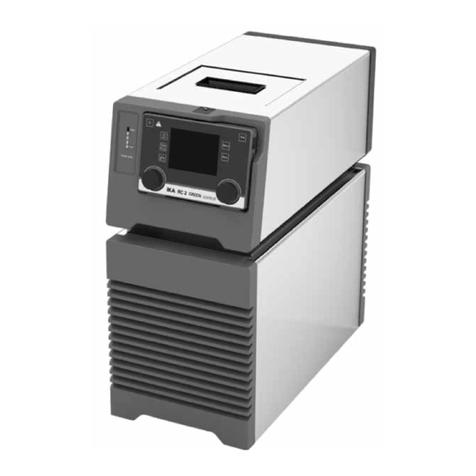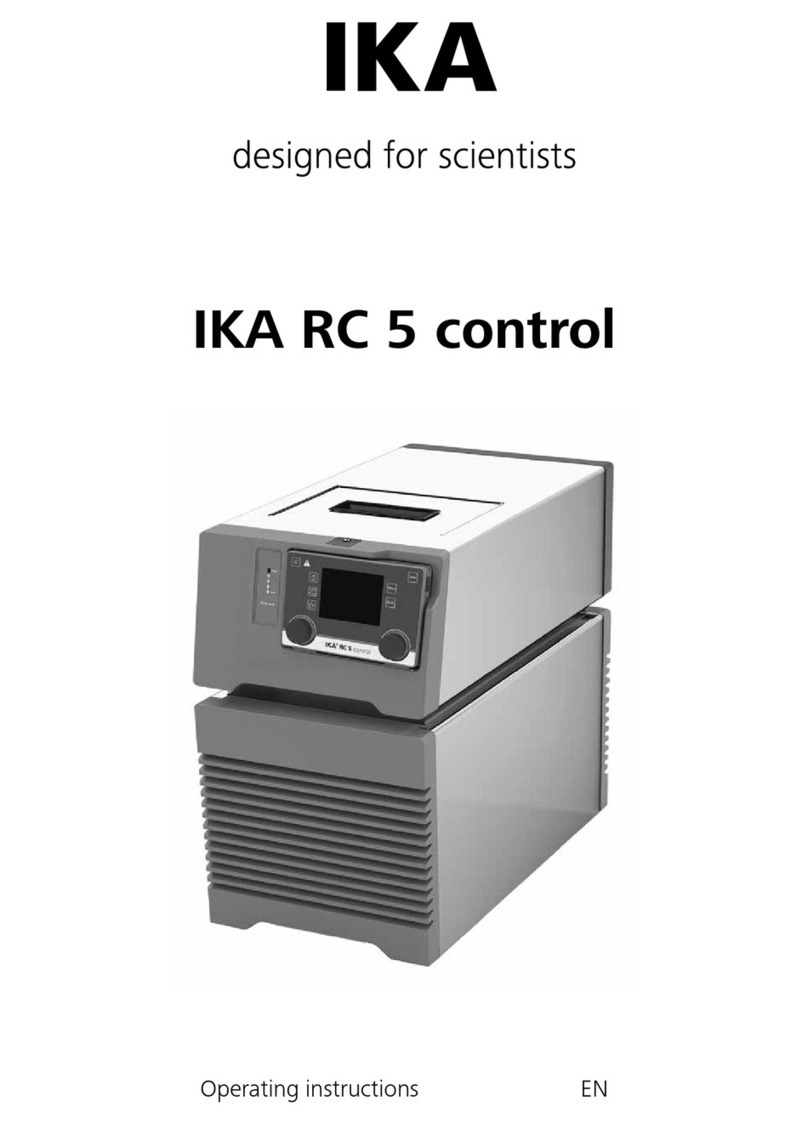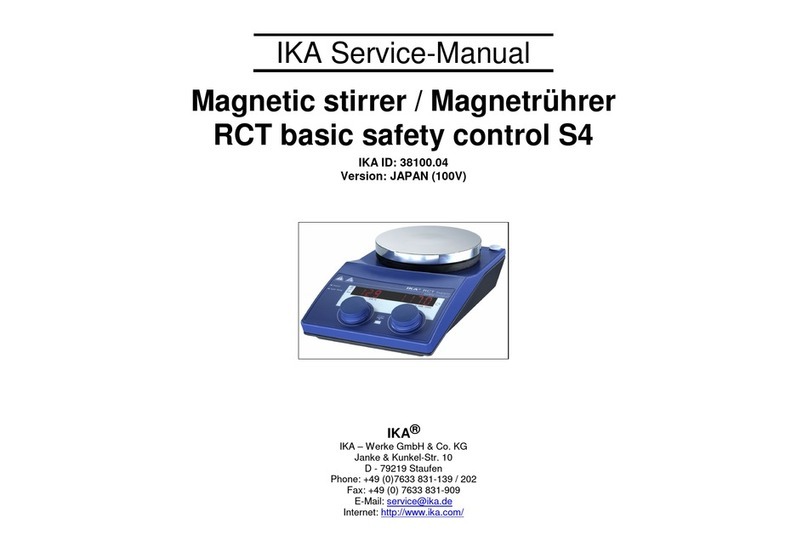
4
• The instrument can only be disconnected from the mains supply by
pulling out the mains plug or the connector plug.
• The socket for the mains cord must be easily accessible.
• Socket must be earthed (protective ground contact).
• The voltage stated on the type plate must correspond to the mains
voltage.
•
Please observe the permitted speed for the stirring element. Never
set higher speed.
• Make certain that the unit is set at the lowest speed before com-
missioning; otherwise, the unit will begin running at the speed set
in last operation. Gradually increase the speed.
•
Pay attention when setting the speed to any imbalance of the stirrer
tools and possible spraying of the medium to be stirred.
Never operate the instrument with the stirrer
tools rotating freely. Ensure that parts of the
body, hair, jewelry or items of clothing cannot be trapped by the
rotating parts.
The operation of a free rotating shaft end is dan-
gerous.
Wear your personal protective equipment in
accordance with the hazard category of the
medium to be processed, otherwise there is a risk of:
- splashing of liquids
- projectile parts
-
body parts, hair, clothing and jewelry getting caught.
Beware of the risk of:
- flammable materials
-
glass breakage as a result of mechanical shaking power.
Reduce the speed if:
- the medium splashes out of the vessel because the speed is too high
- the instrument is not running smoothly
- the instrument begins to move around because of dynamic forces
- an error occurs.
Do not touch rotating parts during op-
eration!
•
There may be electrostatic activity between the medium and
the output shaft which could cause a direct danger.
• After an interruption in the power supply or a mechanical interruption
during a stirring process, the unit does not restart automatically.
• It is important to note that the surfaces of the motor (cooling fins)
and certain parts of the bearing may get very hot during operation.
• Never cover the ventilation slots or cooling fins on the motor or on
the instrument.
• Avoid knocking and impacting on the lower end of the shaft. Even mi-
nor, invisible damage can lead to imbalance and uneven shaft action.
• Ensure that the stand does not start to move.
•
Imbalance of the output shaft and in particular the stirring tools can
lead to uncontrolled resonant vibrational behavior of the instrument
and the whole assembly. Glass apparatus and stirrer containers can
be damaged or shattered by this. It can cause injury to the operator,
also can damage the rotating stirring tool. In this case exchange the
stirring tool for one without imbalance or remedy the cause of the
imbalance.
If there is still imbalance, return it to the dealer or the
manufacturer along with a description of the fault.
• If the instrument is operated too long in overload or if the ambient
temperature is too high, the instrument switches off permanently.
DANGER
DANGER
DANGER
Safety instructions
•
Read the operating instructions in full before starting up and
follow the safety instructions.
• Keep the operating instructions in a place where it can be accessed
by everyone.
• Ensure that only trained staff work with the instrument.
•
Follow the safety instructions, guidelines, occupational health and
safety and accident prevention regulations.
•
Because the options for combining products, tools, stirring vessel,
experiment and medium are nearly endless, user safety cannot be
ensured simply with design requirements on the part of the prod-
uct. For this reason, it may become necessary for users to take
other precautionary safety measures. For example, glass device or
other stirring vessels that are sensitive to mechanical stress can be
damaged or shattered by an imbalance, increasing the speed too
quickly or too little distance between the stirring element and the
stirring vessel. Users can suffer serious injury from glass breakage
or from the freely rotating stirring element.
• Uncontrolled reactions can be triggered by mixing the heated ma-
terial insuciently or by the energy generated by selecting a speed
that is too high. In case of these and other increased operational
hazards, users must take additional appropriate safety precautions
(e.g. shatter protection). In any case, when using critical or hazard-
ous materials in your processes, IKA®recommends to use addi-
tional appropriate measures to ensure safety in the experiment. For
example, users can implement measures that inhibit fire or explo-
sions or comprehensive monitoring equipment. Furthermore, users
must make sure that the OFF switch of the IKA®product can be
accessed immediately, directly and without risk at any time.
If installation or positioning cannot ensure this
access at all times, an additional EMERGENCY
STOP switch that can be easily accessed must be installed in the
work area.
• Only process media that will not react dangerously to the extra
energy produced through processing. This also applies to any extra
energy produced in other ways, e.g. through light irradiation.
• Do not operate the instrument in explosive atmospheres, with haz-
ardous substances or under water.
• Process pathogenic materials only in closed vessels under a suitable
fume hood. Please contact IKA®application support if you have
any question.
• The instrument is not suitable for manual operation.
• The high torque developed by the EUROSTAR requires particular
care in the choice of stand, cross sleeve and anti-rotation element
for the agitating vessel.
• Set up the stand in a spacious area on an even, stable, clean, non-
slip, dry and fireproof surface.
• You must ensure that the stirring element is securely clamped!
• Use stirring shaft protective equipment!
• The agitated vessels used for stirring have to be secured. Consider
on a good stability of the entire structure.
Please pay attention to the dangerous parts of
the equipment in Fig. 8.
•
Protect the instrument and accessories from bumping and impacting.
•
Check the instrument and accessories beforehand for damage each
time when you use them. Do not use damaged components.
• Safe operation is only guaranteed with the accessories described in
the ”Accessories” section.
• Always switch the main switch in the OFF position or disconnect
the power before changing stirring element and fitting allowed ac-
cessories.
DANGER
DANGER
DANGER
DANGER
DANGER






